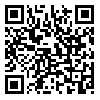Volume 3, Issue 187 (9-2025)
J Except Educ 1404, __(187): 106-106 |
Back to browse issues page
Download citation:
BibTeX | RIS | EndNote | Medlars | ProCite | Reference Manager | RefWorks
Send citation to:



BibTeX | RIS | EndNote | Medlars | ProCite | Reference Manager | RefWorks
Send citation to:
niazi M, helali sotoodeh M, rezaei E, abshirin S. Representation of disability in the film behind the curtain of fog
based on the approach of Laclau and Mouffe. J Except Educ 2025; 3 (187) : 3
URL: http://exceptionaleducation.ir/article-1-2633-en.html
URL: http://exceptionaleducation.ir/article-1-2633-en.html
1- , sotoodem@gmail.com
Abstract: (985 Views)
Abstract
Background and Purpose: Cinema serves as both an indicator and a reflection of societal attitudes and
prevailing social conditions. The depiction and representation of disability in film play a fundamental role in
shaping the social positioning of people with disabilities, as well as influencing public understanding and
awareness of disability. The aim of this study is to examine the discourse of disability and its redefinition in
the film Behind the Mist.
Method: This research employs a qualitative approach, utilizing Laclau and Mouffe’s discourse analysis.
The complete data from the film were described and analyzed based on the discursive components outlined
in Laclau and Mouffe’s theoretical framework.
Results: The findings indicate that, with disability as the central signifier, four semantic systems-support,
education, empowerment, and violence-are constructed within the film. The film’s floating signifiers
include superstition, fatalism, deceit, and frustration. Behind the Mist also represents stereotypes such
as incompatibility and the need for support. Providing appropriate facilities and conditions for people with
disabilities, along with effective policy-making regarding their lives and those of their families, can contribute
to improving their quality of life.
Background and Purpose: Cinema serves as both an indicator and a reflection of societal attitudes and
prevailing social conditions. The depiction and representation of disability in film play a fundamental role in
shaping the social positioning of people with disabilities, as well as influencing public understanding and
awareness of disability. The aim of this study is to examine the discourse of disability and its redefinition in
the film Behind the Mist.
Method: This research employs a qualitative approach, utilizing Laclau and Mouffe’s discourse analysis.
The complete data from the film were described and analyzed based on the discursive components outlined
in Laclau and Mouffe’s theoretical framework.
Results: The findings indicate that, with disability as the central signifier, four semantic systems-support,
education, empowerment, and violence-are constructed within the film. The film’s floating signifiers
include superstition, fatalism, deceit, and frustration. Behind the Mist also represents stereotypes such
as incompatibility and the need for support. Providing appropriate facilities and conditions for people with
disabilities, along with effective policy-making regarding their lives and those of their families, can contribute
to improving their quality of life.
Article number: 3
Keywords: Disability, discourse of Laclau and Mouffe, representation, behind the curtain of fog, cinema
Type of Study: Original Article |
Subject:
General
Received: 2023/Jun/Mon | Revised: 2025/Sep/Tue | Accepted: 2025/Jun/Tue | Published: 2025/Sep/Tue | ePublished: 2025/Sep/Tue
Received: 2023/Jun/Mon | Revised: 2025/Sep/Tue | Accepted: 2025/Jun/Tue | Published: 2025/Sep/Tue | ePublished: 2025/Sep/Tue
Send email to the article author
| Rights and permissions | |
 |
This work is licensed under a Creative Commons Attribution-NonCommercial 4.0 International License. |




